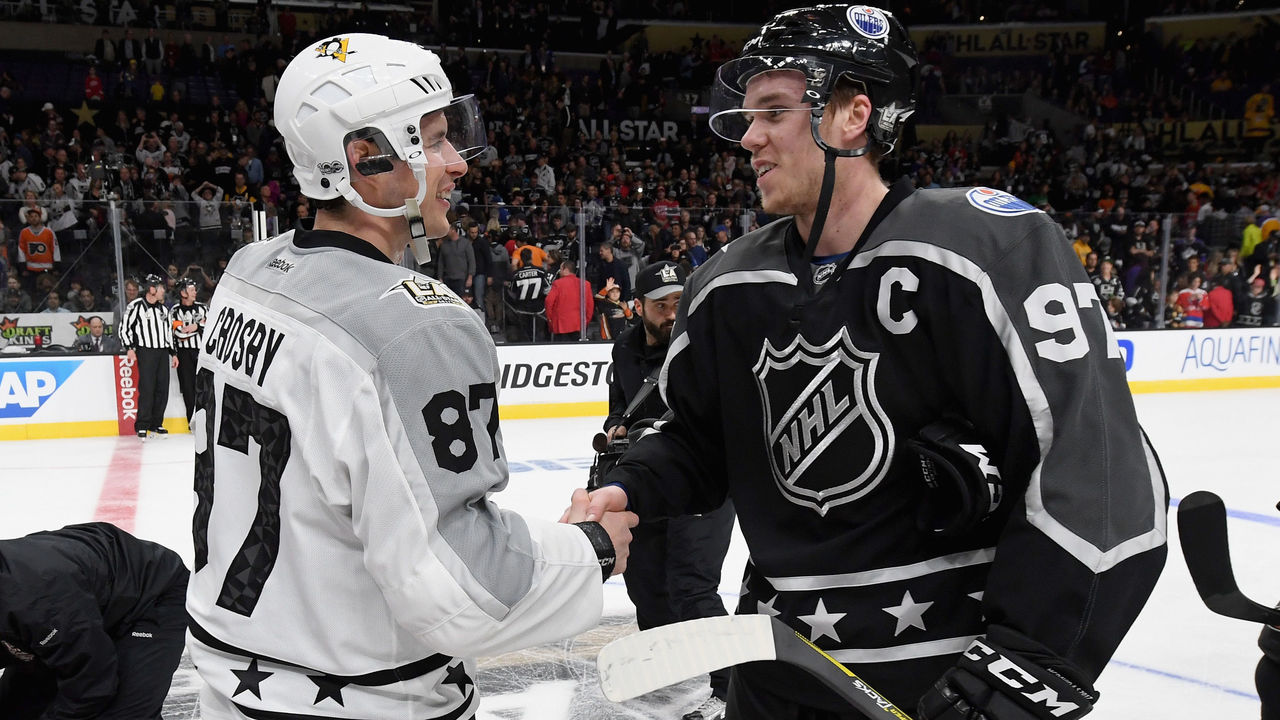After 5 years, how does McDavid stack up against the NHL's greats?
As sports fans, we obsess over the numbers five and 10, and their multiples: five-year dynasty, 10-year anniversary, 25-year era, 50-year title drought.
A notable recent anniversary came and went quietly: Oct. 8 marked five years since Connor McDavid played his first NHL game. The occasion got lost in the shuffle during the busiest week of a weird offseason.
McDavid has either met or exceeded expectations - depending on who you ask - as he approaches his sixth NHL season, which begins on his 24th birthday next Wednesday. And while the Edmonton Oilers have competed in just 17 playoff contests over McDavid's tenure, that's a reflection of the organization's overall performance, not the play of its high-flying superstar.

On a purely individual level, how does McDavid stack up against some of the NHL's all-time greats? Is he on a Sidney Crosby-esque trajectory following five seasons? How far off is he from benchmarks set by Wayne Gretzky?
Using the Hockey Reference database and borrowing ESPN football writer Bill Barnwell's "blind items" format, we're going to break it all down by comparing McDavid's statistical profile with those of Crosby, Gretzky, and other luminaries over the first five seasons of their NHL careers.
Feel free to play along by guessing which stat line represents McDavid in the four groupings below.
Blind item No. 1
Player A: 371 games played, 506 points, 1.36 points per game
Player B: 396 games played, 529 points, 1.34 points per game
Player C: 351 games played, 469 points, 1.34 points per game
It's only natural to start with McDavid, Crosby, and Alex Ovechkin. These transcendent forwards have run roughshod over the competition in the salary-cap era while being marketed as faces of the sport.
Player A is Crosby, McDavid's childhood idol. He went tit for tat with Ovechkin when the international rivals burst onto the scene together in 2005-06. Crosby posted 100 or more points in four of his first five seasons, including a career-high 120 points in his sophomore campaign to earn his first haul of hardware, namely the Hart Trophy. He was unstoppable.
Player B is Ovechkin, the self-proclaimed Russian machine that never breaks. Impressively, Ovechkin missed only 13 regular-season games during his first half-decade in North America. Over that stretch, he averaged an incredible 54 goals a year, including a loony 65-goal barrage in 2007-08. Ovechkin also established the Ovi Spot inside the left circle, which he utilizes to this day.

Player C is, obviously, McDavid. The heir to Crosby's throne as the so-called Next One has, astonishingly, kept pace with the younger versions of Crosby and Ovechkin. McDavid battled through multiple major injuries but his points-per-game rate reflects Ovechkin's and is a sliver behind Crosby's. Each player deploys a different style: McDavid's bread and butter is his next-level skating, Crosby is the perfect blend of power and grace, and Ovechkin is a sharpshooting wrecking ball. But from a production standpoint, all three arrived at essentially the same destination five years into their careers.
When adjusted for era, the rates and rankings change. McDavid becomes the most productive at 1.43 points per game, Crosby slides to second at 1.41, and Ovechkin sits third at 1.39. All three have technically played in the same era, but the NHL's post-lockout jolt of offense in the mid-2000s docks Crosby and Ovechkin within Hockey Reference's adjustment formulas.
No matter the order, the main takeaway is the same: Little separates these three stars, which is high praise for McDavid.
Blind item No. 2
Player A: 351 games played, 161 goals, 0.46 goals per game
Player B: 352 games played, 158 goals, 0.45 goals per game
The mystery player is an active NHLer which means, despite a 10-and-a-half-year age gap, he's a McDavid contemporary of sorts.
Player A is McDavid. Player B is Evgeni Malkin. McDavid edges out early-career Malkin ever so slightly in both total goals scored and goals per game. Injuries also hampered Malkin early in his career, notably a knee injury that cost him half of the 2010-11 season, so they played a similar number of games in their first five years. (As for total ice time, however, McDavid skated for an extra 192 minutes.)

This side-by-side comparison also underlines McDavid's underrated goal-scoring ability. We don't typically think of the Oilers captain as an elite finisher since his crafty playmaking is unparalleled and he doesn't have a 50-goal season to his name. But he does have two 40-goal seasons, and he's one of only eight players in the salary-cap era to put up multiple 40-goal seasons within his first five years in the league.
Malkin, for what it's worth, ranks fourth in goals since entering the league in 2006-07, with 416 in 907 games. And McDavid has kept pace with him through their first five seasons. Malkin was also a year-and-a-half older at his NHL debut than McDavid, who played his first game about three months short of his 19th birthday.
Blind item No. 3
Player A: 324 even-strength points, accounting for 69.1% of all points
Player B: 290 even-strength points, accounting for 74.6% of all points
As lethal as McDavid is on the man advantage, the majority of his production in the NHL has come during even-strength action. To be precise, 69.1% of his total points have been recorded at evens, which includes five-on-five, four-on-four, and three-on-three.
Player B is Jaromir Jagr, arguably the most overqualified sidekick in history. Like McDavid, Jagr - who, at the age of 48, is still playing pro hockey in the Czech Republic - also relied heavily on even-strength ice time to generate offense early in his NHL career. That eye-popping number (74.6% of Jagr's points coming at evens) paces all eight comparison players mentioned in this piece.
Here's a full rundown:
| PLAYER | ES POINTS | TOTAL PTS | % ES |
|---|---|---|---|
| Jaromir Jagr | 290 | 389 | 74.6 |
| Connor McDavid | 324 | 469 | 69.1 |
| Eric Lindros | 300 | 436 | 68.8 |
| Wayne Gretzky | 618 | 914 | 67.6 |
| Alex Ovechkin | 317 | 529 | 59.9 |
| Evgeni Malkin | 250 | 418 | 59.8 |
| Sidney Crosby | 290 | 506 | 57.3 |
| Mario Lemieux | 387 | 715 | 54.1 |
No player falls below 54%, which suggests the greatest offensive players in the world are great in part because they outduel the competition night after night. Special-teams production is certainly important - a point is a point - but it clearly isn't the entree, especially in the extreme cases of McDavid, Jagr, Lindros, and Gretzky.
Blind item No. 4
Player A: 469 points, 1.34 points per game, 503 era-adjusted points, 1.43 era-adjusted points per game
Player B: 436 points, 1.47 points per game, 461 era-adjusted points, 1.55 era-adjusted points per game
Player C: 715 points, 1.94 points per game, 586 era-adjusted points, 1.59 era-adjusted points per game
Player D: 914 points, 2.33 points per game, 722 era-adjusted points, 1.84 era-adjusted points per game
This exercise wouldn't be complete without placing McDavid's era-adjusted point total and per-game rate beside those of Gretzky, Lemieux, and Lindros. The Great One, Super Mario, and Big E were all unique talents - unicorns, even - in the period of hockey history preceding McDavid's career.
The easiest player to identify is Gretzky (Player D). The start of Gretzky's career coincided with an offensive boom across the NHL. Yet those 722 era-adjusted points jump off the page just as much as the unadjusted 914. Gretzky is the high-water mark in any discussion about one skater's impact on the game, regardless of era. The NHL could wipe every goal from Gretzky's resume and he would still hold the record for most career points.
Lindros and Lemieux are Player B and Player C, respectively. Both were 6-foot-4, played center, and shot right. Both also possessed a force-of-nature aura that's lacking from McDavid, Gretzky, and virtually every other great. Unfortunately, Lindros and Lemieux ran into serious injuries in their 30s. Looking back, Lindros' first five seasons stand as his best run, while Lemieux, who rattled off five straight campaigns with 100 or more points to begin his incredible career, boasts an even better era-adjusted point total and per-game average.

All of this is to say McDavid (Player A) has thus far produced offense at a level close to early-career Lindros, at least based on Hockey Reference's calculations. McDavid hasn't been quite as dominant - he's 0.12 era-adjusted points per game behind Lindros - but the statistical comparison is fair. That's a giant compliment, especially since McDavid's situation has been less than ideal in terms of getting support from teammates not named Leon Draisaitl.
To recap: McDavid's first five years in the NHL line up almost seamlessly with the first half-decade of Crosby and Ovechkin's careers in point gathering, his goal-scoring is on par with Malkin's early work, he's dined out in Jagr-like fashion during even-strength action, and Lindros offers a decent cross-generation comparable in era-adjusted points.
Let's not forget McDavid has picked up plenty of hardware through his first five seasons: one Hart Trophy, two Art Ross Trophies, two Ted Lindsay Awards, and three first-team All-Star nods. Plus, he's produced countless highlight-reel plays. He's well on his way to the Hockey Hall of Fame and still in his prime.
Where does McDavid rank on the all-time list of NHL players? Top 50? Top 25? Top 10?! Just kidding. Relax. We'll save that discussion for 2035.
John Matisz is theScore's national hockey writer. Contact him via email (john.matisz@thescore.com) or through Twitter (@MatiszJohn).